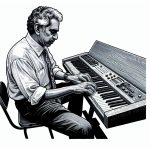Embarking on the journey to learn the keyboard opens up a world of musical possibilities. Whether it's to serenade someone special, join a band, or simply enjoy the therapeutic benefits of playing music, the keyboard is a versatile and accessible instrument for many. But before diving into the world of black and white keys, one might wonder, how much does it actually cost to learn the keyboard?
The answer isn't as straightforward as one might hope. It depends on a variety of factors, including the method of learning one chooses, the type of keyboard they wish to purchase, and how deep they want to dive into the musical adventure. Let's explore what aspiring keyboardists should consider when budgeting for their new skill.
Types of Keyboards for Beginners
When venturing into the world of keyboard learning, one of the first decisions newcomers face is choosing the right type of keyboard. The selection can significantly impact the learner's experience and, by extension, the overall cost of learning the instrument. Keyboards vary in terms of features, sizes, and prices, making it crucial to understand the options before making a purchase.
Digital Pianos are often recommended for beginners who desire an experience close to playing an acoustic piano. These instruments typically feature weighted keys that mimic the touch and feel of a traditional piano and provide a range of sounds that replicate its acoustic counterpart. Digital pianos stand out for their sound quality and realistic playing experience. However, they tend to be on the higher end of the price spectrum due to their advanced features.
Synthesizers, on the other hand, are all about creativity and versatility. They allow players to experiment with a wide array of sounds and effects, making them a popular choice among those looking to produce music or explore various musical genres. Synthesizers can be complex and might overwhelm beginners with their multitude of functions and settings. They're a fit for learners with a keen interest in electronic music or sound design.
Portable Keyboards present an affordable and practical option for beginners. These keyboards are lightweight, compact, and often come with a variety of built-in sounds and rhythms that can make learning fun and engaging. While they may lack the nuanced touch response of higher-end models, portable keyboards offer a good starting point for those on a tight budget or with limited space.
To further illustrate the differences, the following table summarizes the key aspects of each keyboard type:
| Keyboard Type | Key Features | Price Range | Best For |
|---|---|---|---|
| Digital Piano | Weighted keys, high-quality sound replication of acoustic pianos | $$ - $$$ | Beginners seeking a realistic piano experience |
| Synthesizer | Wide array of sounds and effects; great for creativity | $$ - $$$ | Aspiring musicians interested in electronic music |
| Portable Keyboard | Lightweight, compact, various built-in sounds and rhythms | $ - $$ | Beginners on a budget or with limited space |
Cost of Keyboard Lessons

When embarking on the journey of learning the keyboard, an essential aspect to consider is the cost of lessons. The price can vary widely based on several factors, including the instructor's expertise, lesson format, and location. Generally, individual lessons can range from $15 to $60 per session, while more experienced teachers or those located in cities with a high cost of living may charge upwards of $100.
For beginners, group lessons present an affordable alternative. These sessions typically cost less per person, offering a balance of personalized attention and peer interaction. The cost can be as low as $10 per student for each class, making it a budget-friendly option for those just starting out.
Online courses and tutorials have gained popularity, providing flexibility and a wide range of pricing options. Monthly subscriptions to platforms can run from $20 to $50, granting access to extensive libraries of lessons covering various skill levels. Free resources are also available, though they may lack the structured progression and feedback that paid programs offer.
Payment Models
Different instructors and platforms may offer various payment models to suit different needs and budgets:
- Pay-Per-Lesson: Ideal for learners who prefer a flexible schedule without a long-term commitment.
- Monthly Subscription: Offers unlimited access to lessons and materials, suitable for dedicated students.
- Package Deals: Buying lessons in bulk often comes with a discount, appealing to those committed to regular practice.
Additional Costs
Aside from the lesson fees, there are other potential costs associated with learning the keyboard:
- Sheet Music and Books: While some instructors include these in their fees, others may require students to purchase their own, which can add up over time.
- Examination Fees: For students pursuing formal qualifications, exam fees can range from $50 to $200.
- Recital Fees: Participating in recitals or performances may incur additional costs for venue rental and accompanists.
Here's a snapshot of the average costs associated with keyboard lessons:
| Type of Lesson | Average Cost per Session |
|---|---|
| Individual Lessons | $15 - $100+ |
| Group Lessons | $10 - $50 |
| Online Subscriptions | $20 - $50 per month |
Online Resources vs. Private Lessons

When venturing into the world of keyboard learning, students find themselves at a crossroads: choosing between online resources and private lessons. Both paths offer unique advantages and cater to different learning styles, budgets, and schedules. Understanding the pros and cons of each can help learners make an informed decision that best fits their needs.
Advantages of Online Resources
Online resources have dramatically changed the landscape of music education, making it more accessible than ever. They offer several significant benefits:
- Flexibility: Learners can study at their own pace, revisiting lessons as needed. This is particularly beneficial for those with unpredictable schedules.
- Affordability: Many online platforms provide free content or charge less than private tutors. Subscription services offer vast libraries of lessons covering various skills and genres for a monthly fee that often costs less than a single private lesson.
- Variety: From classical to contemporary music, online lessons cover an extensive range of styles, catering to diverse musical interests.
Online learning platforms often include interactive features, such as progress tracking and real-time feedback on playing, enhancing the learning experience.
Advantages of Private Lessons
Private lessons, on the other hand, offer a more personalized learning experience. Key benefits include:
- Tailored Instruction: Tutors can adapt lessons to the student's learning style, pace, and musical interests, providing personalized guidance that online resources cannot match.
- Immediate Feedback: Instructors offer instant feedback on technique, rhythm, and expression, correcting mistakes before they become ingrained habits.
- Motivation and Accountability: Regular lessons with a tutor create a structure that keeps learners motivated. The personal relationship with a tutor adds a layer of accountability that can drive students to practice more diligently.
Private lessons, however, come with higher costs and require a commitment to a scheduled time each week, which may not suit everyone's lifestyle.
Cost Comparison
The decision between online resources and private lessons often comes down to cost. Here is a breakdown of typical expenses associated with each option:
| Type | Cost Range |
|---|---|
| Online Subscriptions | $10-$40 per month |
| Private Lessons | $40-$100 per lesson (30-60 minutes) |
Private lessons can quickly become a significant investment over time, but they offer invaluable personalized guidance. Online resources, while more affordable, require self-discipline and may not provide the same level of tailored instruction or immediate feedback.
Additional Expenses to Consider

When embarking on the journey to learn the keyboard, it's crucial to budget not just for lesson fees but also for additional expenses that might crop up along the way. These costs can vary widely depending on the individual's commitment level, choice of instrument, and the accessories they deem necessary for their learning process.
Purchasing a Keyboard
The first step for any aspiring keyboardist is acquiring an instrument. Prices range significantly based on quality, brand, and features. A basic beginner keyboard can start as low as $100, while more advanced models with a wider range of sounds and weighted keys can go up to $1000 or more. It's advisable to start with a modestly priced instrument and upgrade as one's skills progress.
Sheet Music and Books
While online resources and private lessons often provide materials, investing in a diverse range of sheet music and instructional books can enhance one's learning. This cost varies, but budgeting around $50 to $100 annually should cover the needs of most beginners for new and engaging music pieces.
Maintenance and Repairs
Keyboards, especially those that are transported frequently, can incur wear and tear. Although less maintenance-intensive than acoustic pianos, electronic keyboards may still need occasional repairs or part replacements. Setting aside $50 to $100 a year for potential maintenance should help avoid any surprises.
Headphones and Amplification
For those practicing in shared spaces, headphones are essential. A good pair that minimizes audio leakage can cost anywhere from $25 to $200. Additionally, if one intends to perform, investing in an amplification system might be necessary. Portable amps vary widely in price, starting at around $100 and extending to over $500 for higher-quality sound.
Software and Applications
Many learners supplement their education with software and mobile apps that offer interactive learning experiences. These can range from free to subscription-based services costing up to $20 a month. Selecting ones that align with individual learning goals and budget is key.
Exam Fees
For students pursuing formal qualifications, such as grades from music conservatories, there are exam fees to consider. These exams, which assess progress and proficiency, can cost between $100 and $400 each.
Travel Costs
Attending lessons, workshops, or events outside the home may incur travel costs. While these expenses are highly individual, considering public transport fares or fuel costs for personal vehicles is important for those frequently on the move for their musical education.
Tips for Budgeting Wisely

Navigating through the monetary demands of learning the keyboard requires a strategic approach to budgeting. It's vital for aspiring keyboardists to pinpoint areas where expenses can be trimmed without compromising the quality of their learning experience.
Firstly, they should consider purchasing a used keyboard. Many music enthusiasts upgrade their instruments regularly, which means the market is often flooded with well-cared-for second-hand keyboards. This option can significantly reduce the initial investment while still providing a quality instrument for practice and learning.
Another practical step is to borrow or purchase used sheet music and books. Music sheets and instructional books can be costly when bought new, but many are available at a fraction of the price second-hand. Furthermore, libraries and online platforms often offer free access to these materials, presenting an opportunity for learners to expand their repertoire or theory knowledge without breaking the bank.
For those investing in digital keyboards, leveraging free or affordable software and apps for supplementary learning can be a game-changer. The internet hosts a plethora of educational resources that can enhance the learning process. From interactive tutorials to theory games, there's an abundance of tools available that cater to various skill levels and learning preferences.
| Expense Area | Traditional Cost | Budget-Savvy Alternative |
|---|---|---|
| Instrument Purchase | $500 - $2000 | $100 - $600 (used) |
| Sheet Music & Books | $50 - $200 | $0 - $50 (borrowed/used) |
| Software & Apps | $20 - $200 | $0 - $50 (free/affordable) |
Implementing a regular maintenance schedule for the keyboard can also prevent unforeseen repair costs. Simple actions like dusting the keyboard, avoiding liquid exposure, and storing the instrument properly when not in use can prolong its life and maintain its value. Occasionally, investing in professional servicing can catch issues before they become costly repairs.
Additionally, for those attending keyboard lessons or events outside their home, carpooling or using public transportation can mitigate travel expenses significantly. Planning these logistics in advance can help in budgeting for these costs more efficiently.
Ultimately, managing the financial commitment of learning the keyboard rests on making informed decisions and seeking value. By investing time into researching options and taking advantage of available resources, learners can pave a budget-friendly path towards musical proficiency.
Conclusion
Embarking on the journey to learn the keyboard doesn't have to break the bank. With a bit of creativity and resourcefulness, aspiring musicians can find numerous ways to keep costs low while still enjoying a rich learning experience. Whether it's opting for a pre-loved instrument, sharing resources, or tapping into the wealth of digital tools, the path to mastering the keyboard is accessible to all. Remember, it's the passion for music and the commitment to practice that truly make the difference, not the amount spent. So, dive in, explore your options, and let the music guide you without worrying too much about the financial tune.
Harlan Kilstein began playing piano during covid with no piano background at all. He taught himself how to play learning what to do and what not to do.
Today he's an advanced intermediate player and can help you grow in your skills because he learned all this on his own.








